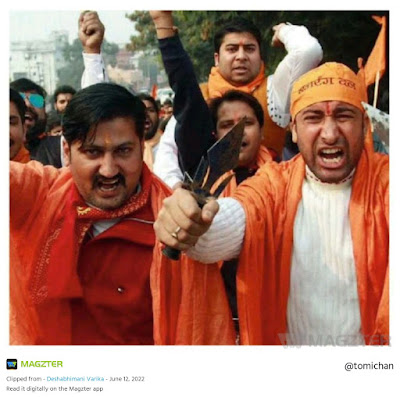In a poem titled ‘Love of
Country,’ Malayalam poet Balachandran Chullikkadu wrote:
In the beginning there were no
countries.
In the beginning was the word.
Then water, and then life.
Then countries came
And love vanished.
A few lines later, the poet
asks:
Where are the borders of solitude?
Where the soul’s lines of control?
What I seek is not love of country,
But a country of love.
An empire of life.
I happened to read an interview
of this poet in the latest issue of Deshabhimani weekly published by
CPI(M). He says that writers are really helpless in shaping people’s thoughts
and attitudes. He cites an example from the time of Indira Gandhi’s Emergency.
Many writers including him questioned Emergency and Indira’s dictatorship in
their poems and other writings. But people elected her to power again.
Writers make little impact on
ordinary people. People are swayed by the rhetoric of politicians and the mumbo
jumbo of the religious. This is truer than ever in contemporary India. See how
political as well as religious leaders mislead millions of people easily in
India now. Blatant lies are accepted as truths. Absolute fraudulence is
embraced by people happily as historical facts. Hatred is preached by people in
power and, worse, by religious leaders. And that hatred is accepted as virtue
by incredibly large numbers of people. 
Balachandran Chullikkadu
Rama’s story, which is nothing
more than good fiction, is passed of as real history and a whole nation is
going to be founded on that fiction which belongs to a period called Treta Yuga
which is nothing more than myth. Balachandran says that in his interview. Don’t
pounce on me now for quoting him. He goes on to argue that the Sangh Parivar is
forging a culture based on a messy admixture of umpteen falsehoods and myths and
assumptions. It is a fake culture that rejects a lot of historical facts and
truths including the protean varieties of miscegenation that created the
Indians of today. There are no pure Indians of any particular race. There are
many bloods, many cultures, many races that went into the shaping of the present
Indians. Sangh Parivar turns a blind eye to too many truths while foisting
endless falsehoods on the people in the name of some imagined pure race. Pity.
The world has started taking
note of this now, thanks to silly people like Nupur Sharma and Naveen Jindal. Nupur
and Naveen are just symbols. The real rot is lying much deeper in the Indian
polity. India has become a cancerous country. It’s going to be a tough job for
any good leader to usher in the much-needed radiation therapy.

Hari Om
ReplyDeleteAgain, I fear, the same is true in so many places; but no doubt about it, India currently is proving to be a beacon of the sort of idealism that was engendered in Germany a hundred years past... and a growing sense of horror fills one's being. YAM xx
I still nurture a hope that India will see the light sooner than later. There are plenty of people who have started questioning the Parivar politics. In the latest byelection in Kerala, BJP couldn't even retain its deposit.
DeleteSo much truth in what you say. The sad part is there are few people with common sense. .......Then countries came ........... and love vanished. - so true.
ReplyDeleteMay more people realise the folly and futility of nationalism.
DeleteMany people knowingly and willingly vote for bad leaders.
ReplyDeleteGyanvapi case should not have been allowed. Places of Worship Act 1991 is ignored. All over India we see demands for demolition of mosques.
And it's not going to end with Gyanvapi. So many others are waiting to be "reclaimed"!
DeleteTomichan... we are warped, that we are creating a ruckus on the basis of a non-religion narrating the stories of non-existing people. To induce a non existing strife so that the attention is diverted from where it has to be.
ReplyDeleteIf only more and more people see as clearly as you do!
DeleteHis lines are so powerful...what we need is country of love not love of country. ...just wow. Hats off to port. Wish writers and poets had. Grt impact...then we all could hav strived to change few things ?!
ReplyDeleteWriters, scientists, artists, etc inhabit a different milieu which is inaccessible to the common person whose mind is stuck with mediocre notions and metaphors.
Delete